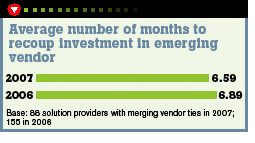Emerging Tech Sectors: What's Hot This Year
Software and storage vendors form the vanguard of CRN's 2007 Emerging Tech Dynamos list of 163 vendors that bring high margins and unique enhancements to VARs' solution-oriented offerings.
Forty percent of the companies on the list classified themselves as software vendors, a significant jump from the 15 percent that populated last year's list. Storage vendors, meanwhile, continue to be hot among solution providers looking for new vendor partners. Twenty-nine percent of the companies on the list focus on storage, up slightly from 28 percent last year.
Emerging vendors concentrating on security was the third most popular sector, coming in at 28 percent but down from 31 percent in 2006.
Other sectors showing growth in 2007 were networking and service vendors. Ten percent of the emerging vendors classified themselves as a networking vendor and 10 percent as a services vendor, up from 7 percent for each category in 2006. VoIP vendors also gained momentum on the 2007 list with 5 percent of the total, up from 3 percent a year earlier. Of all the technology sectors represented on the list, only virtualization showed a marked decline from last year, coming in at 1 percent of this year's group vs. 7 percent last year.
While the leading software category tended to cover the spectrum of solutions and markets, the common factor was that the products enhance VARs' solutions while boosting sales and profits.
Jerry Longsworth, director of sales at Naknan, a solution provider in Houston, said his company just added Persystent Technologies, a Tampa, Fla., software vendor specializing in desktop availability and compliance software. Longsworth said the software automatically monitors PCs and laptops to screen for e-mail viruses and to enforce and maintain operating environments. "If you get an e-mail with a virus or do something that hoses your PC, instead of having to call help desk, it's basically an alt-control-delete reboot, and in less than a minute, you have your PC back," he said. "It saves a lot of headache and downtime."

More importantly, Longsworth said he makes great margins on the product. In addition to margins on product sales, he says Persystent pays 15 percent to 20 percent in back-end rebates. And Naknan can sell consulting and deployment services around the product as well.
"Persystent doesn't want to overdistribute the product," he said. "That's what we look for. We want to focus on the niche products because that's where the profits are."
Other solution providers that have partnered with emerging vendors in the past year say the quest for new, innovative technology solutions rather than higher margins is what drives them to new technology companies. Abtin Assadi, CEO of Celeros, a Redwood City, Calif., storage solution provider, said he partnered with Open-E, an IP storage operating system vendor that offers NAS, iSCSI initiator, iSCSI target, FC initiator and FC target in a single application.
"We are completely technology focused," he said, noting he wouldn't add a new vendor simply because it offered him an opportunity to make more margin. "We are looking to provide best-performance feature sets and we are always looking for what's out there. We are mainly after the best technology for the customer."
Likewise, Stewart Bailey, director of sales and marketing at Cirrus Solutions, a Hayward, Calif., networking integrator, said the quality of the technology is his primary reason for adding a new vendor. He said his company has recently partnered with Trapeze Networks, a wireless LAN equipment vendor that provides Smart Mobile intelligent switching.
While he said that Trapeze is aggressive in pricing its products and providing him with leads and support, its technology really wins the day. He said that Trapeze offers a better technology for handling switching on wireless networks by more efficiently routing voice traffic between access points and thus improving traffic flow over VoIP.
"If the technology wasn't there, I wouldn't have done [the partnership]," Bailey said. "At the end of the day, as a service contractor I have to support that technology. If I'm going out constantly fixing things or it's coming in DOA, it gets expensive to maintain. If you partnered just for the margins, that margin you thought you had you don't have anymore."